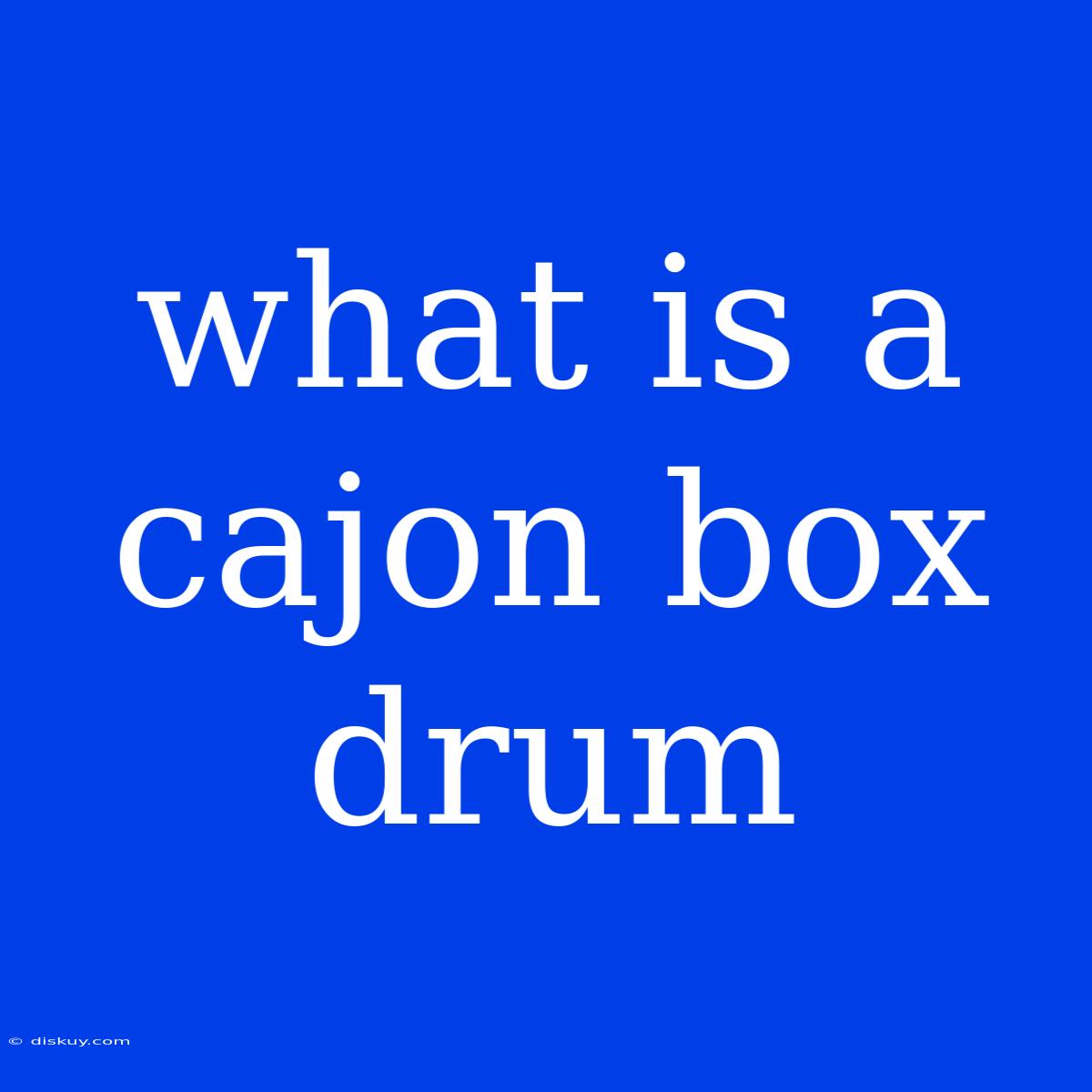What is a Cajon Box Drum? Unveiling the Rhythmic Magic of a Simple Box
Have you ever heard a percussive sound that seems to emanate from a simple wooden box? This is the Cajon, a box drum that has gained immense popularity in recent years.
Editor Note: This article will delve into the world of the Cajon, exploring its history, design, and the unique sounds it produces.
This topic is important because the Cajon has become a widely recognized and beloved instrument among musicians worldwide. It's a versatile, portable, and relatively inexpensive percussion instrument that offers a rich array of sounds, making it ideal for various musical genres.
Our analysis will cover the Cajon's origins, construction, playing techniques, and how it has captured the hearts of musicians across the globe.
Key Aspects of the Cajon
| Aspect | Description |
|---|---|
| Origin | A traditional Peruvian percussion instrument |
| Design | A hollow wooden box with a soundboard |
| Playing Techniques | Striking different areas to create diverse sounds |
| Versatility | Suitable for various musical genres |
Cajon Box Drum: A Journey Through Time
The Cajon's journey traces back to the early days of Spanish colonization in Peru. Initially, slaves used simple wooden boxes as makeshift drums. Over time, the Cajon evolved into the sophisticated instrument we know today. It remained a cherished part of Peruvian folk music until the 20th century, when its popularity spread globally.
The Cajon's Construction: A Symphony of Wood and Sound
The Cajon's design is deceptively simple, yet ingeniously crafted to produce its distinctive sounds. It's essentially a wooden box with a soundboard, typically made of plywood or hardwood. The soundboard, the thin panel at the front, vibrates when struck, creating the Cajon's rich and varied tones.
Soundboard: The Key to the Cajon's Sound
The soundboard is the heart of the Cajon. Its thickness, material, and construction greatly influence the instrument's sound. A thinner soundboard produces a brighter and more resonant tone, while a thicker soundboard creates a deeper and warmer sound.
The "Snare" Effect: Adding Depth to the Sound
Many Cajons feature a "snare" effect, created by internal strings or a metal plate that vibrates when the box is hit. This effect adds a percussive "snap" or "crack" to the sound, adding complexity and depth.
The Cajon's Anatomy: Unraveling the Instrument
- Soundboard: The front panel that vibrates to create sound.
- Body: The hollow box that amplifies the soundboard's vibrations.
- Snare System: Internal strings or a metal plate for adding a "snare" effect.
- Back Panel: The rear panel that helps amplify sound.
Playing the Cajon: A Symphony of Strokes and Sounds
The Cajon's versatility lies in its ability to produce a variety of sounds depending on where it's struck.
The "Slap" Technique: The Foundation of Cajon Sound
The "slap" technique, a sharp, resonant strike delivered with the palm of the hand, forms the foundation of Cajon playing. This technique is used to create the instrument's primary bass and beat sounds.
The "Bass" Technique: Adding a Low-End Punch
To produce a deep, bassy sound, players strike the lower portion of the soundboard with the heel of their hand. This technique adds a rich, low-frequency element to the Cajon's sound.
The "Snare" Technique: Adding Percussive Depth
Striking the soundboard near the snare system creates a percussive "snap" or "crack," adding a rhythmic texture to the Cajon's sound.
Cajon in Music: Embracing the Rhythm
The Cajon's adaptability has made it a sought-after instrument in various music genres.
Folk and Latin Music: The Cajon's Roots
The Cajon's origins in Peruvian folk music are evident in its use in contemporary Latin American and Spanish folk music. Its earthy, percussive sounds blend seamlessly with traditional instruments and styles.
World Music: A Global Rhythm
The Cajon's popularity has extended beyond Latin music, finding its way into various world music genres, including flamenco, jazz, and even rock and pop music. Its versatility allows it to blend seamlessly with diverse musical styles.
Modern Music: A Fusion of Rhythm
The Cajon's distinct sounds and rhythmic capabilities have captivated modern musicians. Its presence in contemporary pop, rock, and fusion bands demonstrates its versatility and appeal to modern musical sensibilities.
Cajon: A Unique and Versatile Instrument
The Cajon, with its simplicity and adaptability, offers a rich sonic experience. It has transcended its humble origins, capturing the hearts of musicians worldwide.
Final Thoughts: Embracing the Cajon's Rhythm
The Cajon's journey from its Peruvian roots to its global embrace is a testament to its inherent musicality. Its simple design, combined with its diverse sound possibilities, makes it an instrument that is both approachable and rewarding to play. Whether you're a seasoned percussionist or a music enthusiast looking for a new sonic adventure, the Cajon is an instrument that promises to captivate your musical journey.

